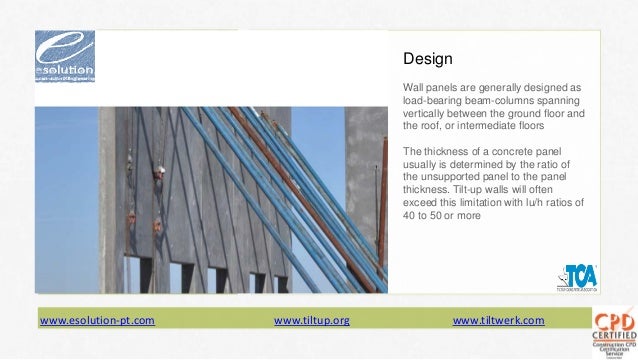The thickness of a concrete panel usually is determined by a quantity called the slenderness ratio.
Tilt up concrete wall thickness.
U values for solid concrete tilt up walls 1 2 inch plasterboard concrete type of 1 4 inch gypsum or thickness concrete by plain plaster 1 4 inch plywood inches weight wall applied to 1 inch rigid insulation normal 74 19 18 6 structural lightweight 43 16 15 normal 65 18 17 8 structural lightweight 35 15 14.
The panels are limited to 12 feet wide for shipping but the contractor doesn t have to mess around with them.
The minimum thickness for commercial walls is generally 5 inches with 7 inches the most typical thickness reinforced with 1 3 to 2 5 psf of reinforcing.
A tilt up building during construction.
This is the ratio of the unsupported panel height usually the distance between the floor slab and the roof stru c t u r e attachment to the panel thickness.
However keep in mind that these can be as little as a few inches thick.
Tilt up panels can be solid concrete or they may be sandwich type construction.
An insulated panel is much thicker as the exterior panel is up to 3 inches the insulation is 2 to 4 inches and the interior wall could be 5 to 10 inches thick.
An 8 x is 7 1 2 inches tall so you next thickness up should be that.
What is the typical thickness of a tilt up concrete panel.
Tilt up construction combines the strength and durability of reinforced concrete with the precision and efficiency of the design build methodology.
Insulation can be incorporated into tilt up to provide energy efficient construction with hard exterior wall surfaces.
For instance a 6 x is 5 1 2 inches tall so start with 5 1 2 inch thick tilt up.
Most tilt up wall panels.
It is common to use extruded polystyrene at 2 to 6 inches thick.
Some as small as 5 000 square feet can be economical if they are relatively tall.
It provides the benefits of solid concrete walled buildings quickly and economically.
Concrete tilt up walls can be very heavy as much as 300 000 pounds 140 t or more.
The generally accepted slenderness ratio on tilt up walls is 50.
O6 guide to tilt up design and construction 1 1general tilt up is a form of construction ideally suited to the rapid realisation of a wide range of buildings for industrial commercial residential and community use.
This one two punch delivers new buildings quickly and economically which might explain why more than 650 million square feet of tilt up buildings go up every year.
Also another approach that worked out well is factory made tilt up.
Other sections are visible.
What is the minimum size building that is economical.

